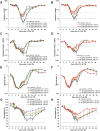The Toll-Like Receptor 5 Agonist Entolimod Mitigates Lethal Acute Radiation Syndrome in Non-Human Primates
- PMID: 26367124
- PMCID: PMC4569586
- DOI: 10.1371/journal.pone.0135388
The Toll-Like Receptor 5 Agonist Entolimod Mitigates Lethal Acute Radiation Syndrome in Non-Human Primates
Abstract
There are currently no approved medical radiation countermeasures (MRC) to reduce the lethality of high-dose total body ionizing irradiation expected in nuclear emergencies. An ideal MRC would be effective even when administered well after radiation exposure and would counteract the effects of irradiation on the hematopoietic system and gastrointestinal tract that contribute to its lethality. Entolimod is a Toll-like receptor 5 agonist with demonstrated radioprotective/mitigative activity in rodents and radioprotective activity in non-human primates. Here, we report data from several exploratory studies conducted in lethally irradiated non-human primates (rhesus macaques) treated with a single intramuscular injection of entolimod (in the absence of intensive individualized supportive care) administered in a mitigative regimen, 1-48 hours after irradiation. Following exposure to LD50-70/40 of radiation, injection of efficacious doses of entolimod administered as late as 25 hours thereafter reduced the risk of mortality 2-3-fold, providing a statistically significant (P<0.01) absolute survival advantage of 40-60% compared to vehicle treatment. Similar magnitude of survival improvement was also achieved with drug delivered 48 hours after irradiation. Improved survival was accompanied by predominantly significant (P<0.05) effects of entolimod administration on accelerated morphological recovery of hematopoietic and immune system organs, decreased severity and duration of thrombocytopenia, anemia and neutropenia, and increased clonogenic potential of the bone marrow compared to control irradiated animals. Entolimod treatment also led to reduced apoptosis and accelerated crypt regeneration in the gastrointestinal tract. Together, these data indicate that entolimod is a highly promising potential life-saving treatment for victims of radiation disasters.
Conflict of interest statement
Figures






Similar articles
-
Radioprotective effect of newly synthesized toll-like receptor 5 agonist, KMRC011, in mice exposed to total-body irradiation.J Radiat Res. 2019 Jul 1;60(4):432-441. doi: 10.1093/jrr/rrz024. J Radiat Res. 2019. PMID: 31165150 Free PMC article.
-
Entolimod as a radiation countermeasure for acute radiation syndrome.Drug Discov Today. 2021 Jan;26(1):17-30. doi: 10.1016/j.drudis.2020.10.003. Epub 2020 Oct 13. Drug Discov Today. 2021. PMID: 33065293 Review.
-
Mitigation of Radiation-Induced Epithelial Damage by the TLR5 Agonist Entolimod in a Mouse Model of Fractionated Head and Neck Irradiation.Radiat Res. 2017 May;187(5):570-580. doi: 10.1667/RR14514.1. Epub 2017 Mar 21. Radiat Res. 2017. PMID: 28323577 Free PMC article.
-
An agonist of toll-like receptor 5 has radioprotective activity in mouse and primate models.Science. 2008 Apr 11;320(5873):226-30. doi: 10.1126/science.1154986. Science. 2008. PMID: 18403709 Free PMC article.
-
γ-Tocotrienol as a Promising Countermeasure for Acute Radiation Syndrome: Current Status.Int J Mol Sci. 2016 May 3;17(5):663. doi: 10.3390/ijms17050663. Int J Mol Sci. 2016. PMID: 27153057 Free PMC article. Review.
Cited by
-
Protection against Radiotherapy-Induced Toxicity.Antioxidants (Basel). 2016 Jul 5;5(3):22. doi: 10.3390/antiox5030022. Antioxidants (Basel). 2016. PMID: 27399787 Free PMC article. Review.
-
A Metabolomic and Lipidomic Serum Signature from Nonhuman Primates Administered with a Promising Radiation Countermeasure, Gamma-Tocotrienol.Int J Mol Sci. 2017 Dec 28;19(1):79. doi: 10.3390/ijms19010079. Int J Mol Sci. 2017. PMID: 29283379 Free PMC article.
-
A first-in-human study of KMRC011, a potential treatment for acute radiation syndrome, to explore tolerability, pharmacokinetics, and pharmacodynamics.Clin Transl Sci. 2021 Nov;14(6):2161-2170. doi: 10.1111/cts.13073. Epub 2021 Jun 10. Clin Transl Sci. 2021. PMID: 34080313 Free PMC article. Clinical Trial.
-
Toll-like Receptor Agonist CBLB502 Protects Against Radiation-induced Intestinal Injury in Mice.In Vivo. 2024 Jul-Aug;38(4):1636-1648. doi: 10.21873/invivo.13613. In Vivo. 2024. PMID: 38936936 Free PMC article.
-
Radiomitigation by Melatonin in C57BL/6 Mice: Possible Implications as Adjuvant in Radiotherapy and Chemotherapy.In Vivo. 2022 May-Jun;36(3):1203-1221. doi: 10.21873/invivo.12820. In Vivo. 2022. PMID: 35478105 Free PMC article.
References
-
- Waselenko JK, MacVittie TJ, Blakely WF, Pesik N, Wiley AL, Dickerson WE, et al. Medical management of the acute radiation syndrome: recommendations of the Strategic National Stockpile Radiation Working Group. Ann Intern Med. 2004;140(12):1037–51. . - PubMed
Publication types
MeSH terms
Substances
Grants and funding
LinkOut - more resources
Full Text Sources
Other Literature Sources
Medical

